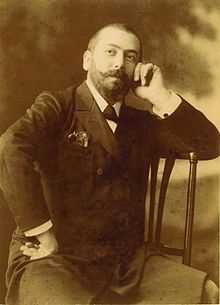Marius Sestier
| Marius Sestier | |
|---|---|
 Sestier in 1896, photographed by Henry Walter Barnett | |
| Born |
Marius Ely Joseph Sestier 8 August 1861 Sauzet, Drôme, France |
| Died |
8 November 1928 (aged 67) Sauzet, Drôme, France |
| Occupation | Cinematographer, pharmacist |
Marius Ely Joseph Sestier (8 September 1861 – 8 November 1928)[1] was a French cinematographer. Sestier was best known for his work in Australia, where he shot some of the country's first films.
Born in Sauzet, Drôme, Sestier was a pharmacist by profession.[1] He was employed by early filmmakers the Lumière brothers (Auguste and Louis Lumière) to demonstrate their cinématographe abroad.[2] In this capacity he travelled to India in June 1896,[3] where he held a showcase of six short films made by the Lumière brothers at Watson's Hotel, Bombay on 7 July 1896;[4] this was the first time moving pictures had been shown in India.[5] Sestier also shot his own films while in Bombay, but the Lumière brothers rejected these for their catalogue as they were not satisfied with the quality.[6]
Sestier had met Australian photographer Henry Walter Barnett while travelling from Europe to India, and after Sestier completed his work in India they travelled to Sydney together.[2] In September 1896 Sestier opened Australia's first cinema, the Salon Lumière in Pitt Street, Sydney.[7] Sestier and Barnett began making their own films, starting with a short film of passengers disembarking from the ship S.S. Brighton in Manly, which was the first film shot and screened in Australia.[8] Sestier and Barnett made approximately 19 films together in Sydney and Melbourne,[8] most notably a film of the 1896 Melbourne Cup horse race. The feature, which consisted of 10 one-minute films shown in chronological order (separate films were required due to limitations of cameras of the time),[2] was premiered at the Princess Theatre, Melbourne on 19 November 1896,[9] with Sestier giving an accompanying lecture. It was covered in the Australian press, including The Age and The Bulletin, and has been cited as Australia's first film production.[2]
After his business partnership with Barnett ended Sestier continued to tour Australia, demonstrating the cinématographe and showcasing films until May 1897. After returning to France he went on to become director of the Lumière Patents Company.[3]
References
- ↑ 1.0 1.1 Raynal, Cécile (April 2010). "Un pharmacien des Lumière: Marius Sestier (1861–1928)". Revue d'Histoire de la Pharmacie (Société d'Histoire de la Pharmacie) 58 (365): 7–30. Retrieved 10 March 2014. Extract at Sauzet en Drôme Provençale.
- ↑ 2.0 2.1 2.2 2.3 FitzSimons, Trish; Laughren, Pat; Williamson, Dugald (2011). Australian Documentary: History, Practices and Genres. Melbourne: Cambridge University Press. pp. 33–34. ISBN 9780521167994.
- ↑ 3.0 3.1 Long, Chris; McKernan, Luke (February 2010). "Marius Sestier". Who's Who of Victorian Cinema. Retrieved 10 March 2014.
- ↑ Kumar, Anuj (15 February 2013). "Indian cinema one of the most generous in the world today". The Hindu. Retrieved 10 March 2014.
- ↑ Ganti, Tejaswini (2011). Bollywood: A Guidebook to Popular Hindi Cinema. New York: Routledge. p. 6. ISBN 9780415583848.
- ↑ Barnouw, Erik (1993). Documentary: A History of the Non-fiction Film (2nd revised ed.). New York: Oxford University Press. p. 15. ISBN 0195078985.
- ↑ "Marius Sestier Collection". Australia: National Film and Sound Archive. Retrieved 10 March 2014.
- ↑ 8.0 8.1 Jackson, Sally (1 September 2010). "Patineur Grotesque: Marius Sestier and the Lumière Cinématographe in Australia, September–November 1896". Screening the Past. La Trobe University. Retrieved 10 March 2014.
- ↑ Jackson, Sally (1 November 2013). "Melbourne Cup fashion, 1896". Australia: National Film and Sound Archive. Retrieved 11 March 2014.